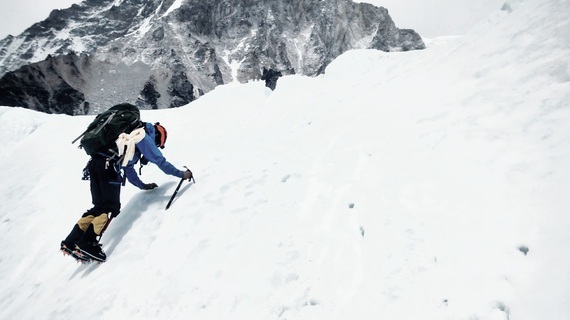
"Fear is healthy; Panic is deadly."
I believe in this quote, said by Frosty Hesson, world-class surfer famous for surfing gigantic waves known as "Mavericks," because I can relate. While it's safe to say I'm nowhere near being a pro surfer, as a mountaineer, I have similarly felt real fear. And, as Hesson implies, used it in a positive, healthy way.
We often forget that fear and panic are not the same things; one is necessary to stay alive, and the other is not. Panic is actually dangerous, putting a person in a state of complete chaos, removing the ability to make sound life-saving decisions. I've experienced both emotions many times -- and not just on the mountain -- but also at work and in my personal life.
I've found that the best way to avoid panic in your life is to explore your real fears, why they happen, when they happen and how they happen. Understanding your fears will employ you with the tools necessary to avoid a dangerous panicky state. It's definitely easier said than done, requiring courage and determination, but once you figure out what your real fears are it's easier figure out how they can be managed. That said, there's no magic bullet here; perseverance and hard work are the only ways to go.
I remember the first time I was in the Everest valley learning basic mountaineering skills on a steep rock face. I went up fine but while coming down, I became terrified, completely filled with fear. As a child, I had a near fatal rappelling accident and this particular situation mentally put me right back to that experience, leaving me panicked.
My mind entered a chaotic state. I couldn't hear anything; I couldn't see anything, and thousands of thoughts filled my mind at once. My brain was completely overwhelmed as our expedition leader shouted at me, but I couldn't hear a thing.
However, as scary as that moment was, it's real life experiences such as this that change a person. How you react in these moments is what defines you. After a few minutes of letting the panic wash over me, I calmed down -- I had to. I realized that just slowing your heart and returning your mental state to the present is the first solution in a panic situation.
The next thing I remembered was a loud voice in my ear from my climb leader, "Kuntal, stop leaning forward or you will die." I snapped out of it. It was clear to me at this moment where I was going wrong, and that all I had to do was take a better posture and begin walking down slowly.
Over the course of next few years, my fear lessened as I became more proficient at rappelling. In fact, I eventually went on a two-day canyoning trip where I descended an 800-foot long canyon with more than 10 rappels through waterfalls and rough terrain.
I'd be lying if I said I didn't always feel a small amount of fear while climbing -- especially during rappelling - but I've learned how to manage my fear by identifying the cause. There's no need to fear, well, fear. Turn an uneasy feeling into a great tool to help you learn more about yourself and avoid unnecessarily dangerous situations.
Learn more about my path to overcoming fear on my journey to climb Everest, as well an opportunity for you to submit a mission to face your fears and have your dreams come true at FUEL.
